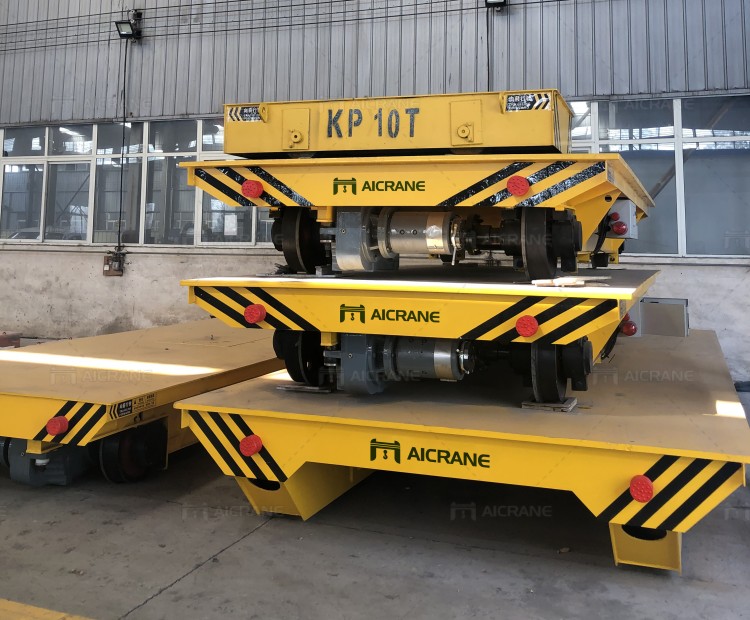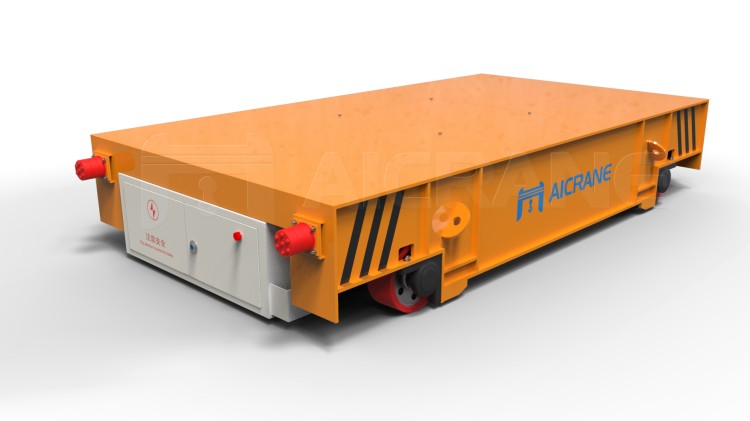A transfer cart is a type of material handling equipment that is designed to transport heavy loads within a facility. It typically consists of a flat platform with wheels or casters that can move along a track or on the floor. The platform may be powered or manually pushed/pulled.
Transfer carts are commonly used in manufacturing facilities, warehouses, and other industrial settings to move materials and products from one location to another. They are often used in conjunction with overhead cranes or other lifting equipment to transfer loads between workstations or storage areas.

Different Types of Transfer Carts
Battery-powered transfer carts: These carts are powered by batteries and are ideal for moving heavy loads over longer distances. They can be operated remotely or through a control panel on the cart itself.
Rail-guided transfer carts: These carts are designed to run on a fixed rail or track system. They are often used in assembly line production where a consistent path is required.
Manual transfer carts: These carts are manually pushed or pulled and are ideal for shorter distances and lighter loads.
Automated guided vehicles (AGVs): These are computer-controlled transfer carts that are designed to move autonomously within a facility. They are often used in large manufacturing facilities and warehouses to transport goods between different areas.
Transfer carts are versatile and can be customized to meet specific material handling requirements. They can be designed to accommodate various load sizes, shapes, and weights, and can be equipped with features such as ramps, turntables, and hydraulic lifts.

Safe Operation of Transfer Cart
Transfer carts are an essential piece of material handling equipment, but they can also be dangerous if not used properly. Here are some safety tips to keep in mind when using a transfer cart:
Proper training: All operators of transfer carts should receive proper training before operating the equipment. This includes understanding the controls, proper use of safety devices, and how to handle and move loads safely.
Inspect the cart before use: Before using a transfer cart, inspect it to ensure that all components are in good condition, including the wheels, brakes, and safety devices. Any issues should be addressed before use.
Load capacity: Always ensure that the load being transported is within the specified load capacity of the cart. Overloading a cart can result in instability and tipping.
Secure loads: Securely fasten loads to the transfer cart to prevent them from shifting or falling during transport.
Avoid speed: Always operate the transfer cart at a safe speed, especially when turning or operating on uneven surfaces.
Observe the environment: Be aware of the surrounding environment and avoid obstacles or obstructions that can cause the cart to tip or lose control.
Use safety devices: Transfer carts should be equipped with safety devices, such as emergency stop buttons, horns, and warning lights. Operators should be trained to use these devices appropriately.
Follow safety protocols: Always follow safety protocols, such as wearing appropriate personal protective equipment and using safety harnesses when working at heights.
By following these safety tips, you can help prevent accidents and injuries when using a transfer cart. It’s important to prioritize safety in any material handling operation to ensure the well-being of workers and the efficient operation of your facility. For more information of material handling equipment, you can visit this website https://ellsencranes.com/.